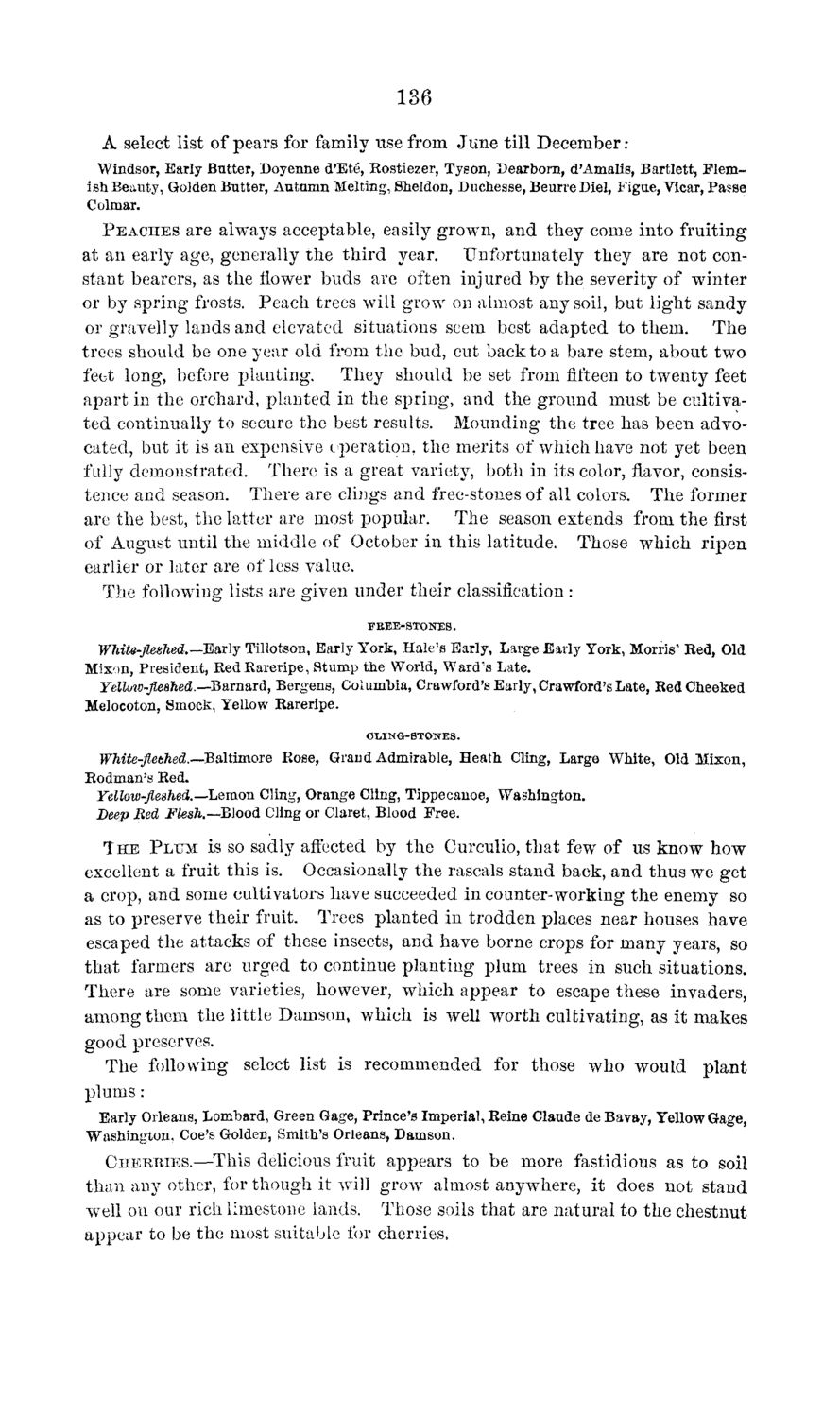| |
| |
Caption: Board of Trustees Minutes - 1869
This is a reduced-resolution page image for fast online browsing.

EXTRACTED TEXT FROM PAGE:
136 A select list of pears for family use from J u n e till December : Windsor, Early Butter, Doyenne d'Ete, Rostiezer, Tyson, Dearborn, d'Amalis, Bartlett, Flemish Beauty, Golden Butter, Autumn Melting, Sheldon, Duchesse, Beiirre Diel, Figue, Vicar, Passe Colmar. P E A C H E S are always acceptable, easily grown, and they come into fruiting at an early age, generally the third year. Unfortunately they are not constant bearers, as the flower buds are often injured by the severity of winter or by spring frosts. Peach trees will grow on almost any soil, but light sandy or gravelly lands and elevated situations seem best adapted to them. The trees should be one year old from the bud, cut back to a bare stem, about two feet long, before planting. They should be set from fifteen to twenty feet apart in the orchard, planted in the spring, and the ground must be cultivated continually to secure the best results. Mounding the tree has been advocated, but it is an expensive c peration, the merits of which have not yet been fully demonstrated. There is a great variety, both in its color, flavor, consistence and season. There are clings and free-stones of all colors. The former are the best, the latter are most popular. The season extends from the first of August until the middle of October in this latitude. Those which ripen earlier or later are of less value. The following lists are given under their classification : FREE-STONES. White-fleshed,—Early Tillotson, Early York, Hale's Early, Large Early York, Morris1 Red, Old Mixon, President, Red Rareripe, Stump the World, Ward's Late. Yellow-fleshed.—Barnard, Bergens, Columbia, Crawford's Early, Crawford's Late, Red Cheeked Melocoton, Smock, Yellow Rareripe. OLING-STOKES. White-fle&hed.—Baltimore Rose, Grand Admirable, Heath Cling, Large White, Old Mixon, Rodman's Red. Yellow-fleshed.—Lemon Cling, Orange Cling, Tippecanoe, Washington. Deep Red Flesh.—Blood Cling or Claret, Blood Free. T H E P L U M is so sadly affected by the Curculio, that few of us know how excellent a fruit this is. Occasionally the rascals stand back, and thus we get a crop, and some cultivators have succeeded in counter-working the enemy so as to preserve their fruit. Trees planted in trodden places near houses have escaped the attacks of these insects, and have borne crops for many years, so that farmers are urged to continue planting plum trees in such situations. There are some varieties, however, which appear to escape these invaders, among them the little Damson, which is well worth cultivating, as it makes good preserves. The following select list is recommended for those who would plant plums: Early Orleans, Lombard, Green Gage, Prince's Imperial, Reine Claude de Bavay, Yellow Gage, Washington. Coe's Golden, Smith's Orleans, Damson. CHERRIES.—This delicious fruit than any other, for though it will well on our rich limestone lands. appear to be the most suitable for appears to be more fastidious as to soil grow almost anywhere, it does not stand Those soils that are natural to the chestnut cherries,
| |